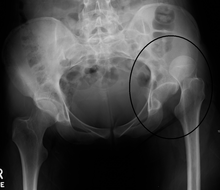User:Mr. Ibrahem/Hip dislocation
| Dislocation of hip | |
|---|---|
 | |
| X-ray showing a joint dislocation of the left hip. | |
| Specialty | Orthopedics |
| Symptoms | Hip pain, trouble moving the hip[1] |
| Complications | Avascular necrosis of the hip, arthritis[1] |
| Types | Anterior, posterior[1] |
| Causes | Trauma[1] |
| Diagnostic method | Confirmed by X-rays[2] |
| Differential diagnosis | Hip fracture, hip dysplasia[3] |
| Prevention | Seat-belts[1] |
| Treatment | Reduction of the hip carried out under procedural sedation[1] |
| Prognosis | Variable[4] |
| Frequency | Uncommon[5] |
A hip dislocation is a disruption of the joint between the femur and pelvis.[1] Specifically it is when the ball–shaped head of the femur comes out of the cup–shaped acetabulum of the pelvis.[1] Symptoms typically include pain and an inability move the hip.[1] Complications may include avascular necrosis of the hip, injury to the sciatic nerve, or arthritis.[1]
Dislocations are typically due to significant trauma such as a motor vehicle collision or fall from height.[1] Often there are also other associated injuries.[2][6] Diagnosis is generally confirmed by plain X-rays.[2] Hip dislocations can also occur follow a hip replacement or from a developmental abnormality known as hip dysplasia.[7]
Efforts to prevent the condition include wearing a seat-belt.[1] Emergency treatment generally follows advanced trauma life support.[2] This is generally followed by reduction of the hip carried out under procedural sedation.[1] A CT scan is recommended following reduction to rule out complications.[8] Surgery is required if the joint cannot be reduced otherwise.[2] Often a few months are required for healing to occur.[1] [9]
Hip dislocations are uncommon.[5] Males are affected more often than females.[3] Traumatic dislocations occurs most commonly in those 16 to 40 years old.[4] The condition was first described in the medical press in the early 1800s.[2]
References[edit]
- ^ a b c d e f g h i j k l m n "Hip Dislocation". AAOS. June 2014. Retrieved 7 June 2018.
- ^ a b c d e f Beebe, MJ; Bauer, JM; Mir, HR (July 2016). "Treatment of Hip Dislocations and Associated Injuries: Current State of Care". The Orthopedic Clinics of North America. 47 (3): 527–49. doi:10.1016/j.ocl.2016.02.002. PMID 27241377.
- ^ a b Blankenbaker, Donna G.; Davis, Kirkland W. (2016). Diagnostic Imaging: Musculoskeletal Trauma E-Book. Elsevier Health Sciences. p. 495. ISBN 9780323442954.
- ^ a b 1967-, Egol, Kenneth A. (2015). Handbook of fractures. Koval, Kenneth J., Zuckerman, Joseph D. (Joseph David), 1952-, Ovid Technologies, Inc. (5th ed.). Philadelphia: Wolters Kluwer Health. p. Chapter 27. ISBN 9781451193626. OCLC 960851324.
{{cite book}}:|last=has numeric name (help)CS1 maint: multiple names: authors list (link) - ^ a b "Hip Dislocation". www.orthobullets.com. Retrieved 7 June 2018.
- ^ Clegg, TE; Roberts, CS; Greene, JW; Prather, BA (April 2010). "Hip dislocations--epidemiology, treatment, and outcomes". Injury. 41 (4): 329–34. doi:10.1016/j.injury.2009.08.007. PMID 19796765.
- ^ Callaghan, John J.; Rosenberg, Aaron G.; Rubash, Harry E. (2007). The Adult Hip. Lippincott Williams & Wilkins. p. 1032. ISBN 9780781750929.
- ^ "Hip Dislocations". Merck Manuals Professional Edition. August 2017. Retrieved 7 June 2018.
- ^ Clarke, Sonya; Santy-Tomlinson, Julie (2014). Orthopaedic and Trauma Nursing: An Evidence-based Approach to Musculoskeletal Care. John Wiley & Sons. p. 292. ISBN 9781118438848.
